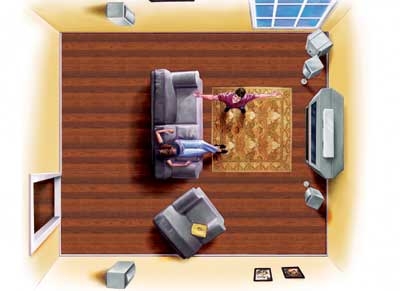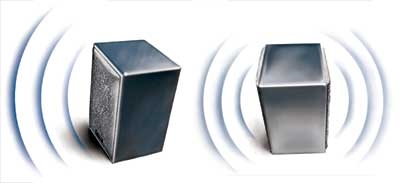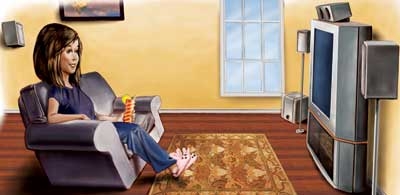Back to Basics: Surround Sound Speakers Page 3
Speaker and Receiver Setup Proper speaker setup makes the difference between a seamless 360° sound field that draws you into the onscreen action and an array of disconnected boxes blaring at you. Symmetry is critical. Speakers won't "image" properly - that is, place the dialogue, music, and effects within the sound field at the correct distance and direction - unless they're set up as symmetrically as possible.  The most common home theater setup has the left and right front speakers to the sides of the TV with the center speaker atop the set. The subwoofer is the front corner and the surround speakers are just behind and above the listening position on the side walls.
The most common home theater setup has the left and right front speakers to the sides of the TV with the center speaker atop the set. The subwoofer is the front corner and the surround speakers are just behind and above the listening position on the side walls.  Almost all front speakers are direct-radiating (above left), while many surround speakers are bipoles or dipoles (above right), with sound radiating equally from the front and back of the cabinet.
Almost all front speakers are direct-radiating (above left), while many surround speakers are bipoles or dipoles (above right), with sound radiating equally from the front and back of the cabinet.
Position the left and right front speakers like mirror images of each other, either facing straight out or "toed in" toward the listening position at the same angle. Often, the owner's manual will recommend which orientation is best. Ideally (you might have to allow for your TV, room, and furniture), the speakers should be about the same distance from each other - far enough apart for a good stereo spread - as they are from the listening position. Divide the wall behind the speakers into thirds and place the left and right speakers at the one-third and two-thirds points, then move them an equal distance out into the room. Experiment with different speaker placements to achieve the smoothest blend between the three front speakers. If you mount the left and right front speakers on stands or on the wall, make sure their tweeters are at or close to ear level when you're sitting down.
The most common place for the center speaker is atop the TV, slightly behind the left and right front speakers (if they're not wall-mounted) and no more than 2 feet above or below their tweeters. Some companies recommend placing the three front speakers in an arc, with all three equidistant from the listening position. With a flat-panel TV, you can mount the center speaker above or below it, tilted up or down toward the listener to achieve the best blend with the left and right front speakers.  Just placing the center speaker atop most TVs would send the sound over your head. Almost all center speakers are designed to allow you to tilt them toward the listening position.
Just placing the center speaker atop most TVs would send the sound over your head. Almost all center speakers are designed to allow you to tilt them toward the listening position.
There are two kinds of surround speakers: front-firing, or direct-radiating - the type included with most satellite/subwoofer systems - and dipole or bipole, which radiate equally from the front and back to create a more diffuse sound. Mount direct-radiating surround speakers on the side walls, slightly behind the listening position and above ear level. Aim them into the room, unless the manufacturer recommends otherwise. If you can't mount them on the side wall, place them along or on the rear wall, aimed toward the front of the room. Mount dipoles or bipoles on the side walls slightly behind the listening position and above ear level, with their driver sides facing forward and backward and the "null" (cabinet) side pointed toward the listener.
Subwoofer placement can be tricky, because all rooms have nodes - areas that weaken or strengthen bass. Place the sub in the front corner, and after working through your receiver's setup menu (covered below), use the sub's controls for level and - if it has them - crossover frequency, phase, and equalization to adjust it for a smooth bass-to-treble balance with the five main speakers. (See the owner's manual for setup advice.) If you can't get a seamless blend, place the sub on an angle in the corner (if the driver fires from the side of the cabinet) or move it to a back corner.
- Log in or register to post comments





























































